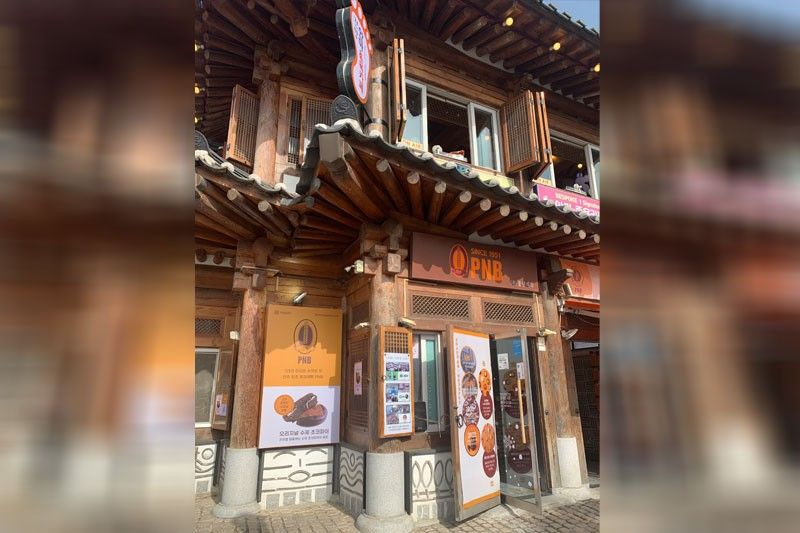How I ate my way through Korea without a visa


Filipinos can now live their The Hungry and the Hairy food dreams any time soon as the Korean government has allowed visa-free entry to three of its destinations — Jeju Island, Gangwon Province, and most recently, the Jeolla Province — via the Muan International Airport.
These places figured prominently in Netflix’s The Hungry and the Hairy, where good friends, Korean star Rain and Noh Hong Chul, travel all over Korea and immerse themselves in the culinary offerings and scenic locales around the country.
While watching the series, I made mental notes of some of the dishes I should try on my next Korean trip. Topping the list was the Soy Marinated Blue Crabs, the only dish featured in the show that put Rain and Hong Chul in a food coma.
Crab a bite
On a recent media familiarization trip organized by the Korea Tourism Organization (KTO) to Jeolla Province, I finally — and unexpectedly — ticked Soy Marinated Crab off my (food) bucket list.
We were at a local restaurant in Suncheon, the largest city in Jeollanam-do, which specializes in hanjeongsik, a traditional Korean course meal with a variety of banchan (side dishes). It was our third day in Korea, and by this time we already had a fair share of the local fare. Or so I thought. Because once all the banchan was laid on the table, I spotted something that tickled my taste buds — raw crabs cut in half, the roe glistening like liquid gold.
And so, while the rest enjoyed every spoonful of the hearty, delicious, and comforting dried radish leaf doenjang jjigae and seasoned cockles, I had my eyes and chopsticks set only on ganjang gejang or Soy Marinated Blue Crabs.
What surprised me even more was no one was paying attention to it except moi, John Legaspi of Manila Bulletin, and sajangnim Dorothy Lauron-Aytona of Skynet Travel Corporation. Lucky us, indeed!
Gejang is made by marinating the blue crabs in soy sauce (gajang), which is rich in gamchilmat, also known as umami. And since just a tiny piece is packed with deep crab flavors, eating an entire crab would easily require a bowl of steamed rice.
And just like what Rain and Noh did in The Hungry and the Hairy, I ate the marinated crabs with gusto! Since the raw crab meat’s texture is similar to Jell-O, the best way to enjoy it is to take a leg and suck everything up. Use your teeth to lightly break off the shell. A spoonful of rice balances its sweet, salty, juicy flavor and luscious texture.
If the crabs are bigger, save the back shell part for last. Using chopsticks, scoop up the crab roe and everything that’s stuck on the edges, put rice on the shell, add soy sauce, and enjoy!
According to our tour guide, Jade, the best way to enjoy fresh gejang is around May, as that’s when female crabs bear roe.
I’ve never had marinated crabs before and this was definitely special. Also, just writing about it makes my mouth water with delight!

Jeonju: The home of bibimbap and more
Touted as Korea’s Food Capital, Jeonju is the only Creative City of Gastronomy designated by the United Nations Educational Scientific and Cultural Organization in the country. It was the first stop of our trip to Korea’s Jeollabuk-do and Jeollanam-do provinces.
This was my second time in Jeonju, and I must admit that the place is quite special and, yes, lovelier the second time around.
In August 2022, I was also part of a media fam trip to Korea. At that time, health protocols were still in place. Tourists were required to undergo COVID testing upon landing at Incheon International Airport. It would take three hours to get the results via email.
After the test, the group boarded the coach, which would take us to our first stop: Jeonju. And just as I was about to enjoy a bowl of bibimbap from Hankookjib, the oldest bibimpab restaurant in the province, I got the dreaded email from the Korea Ministry of Health and Welfare. To make a long story short, I spent the longest seven days of my life in a boutique hotel in Jeonju.
Talk about revenge travel. And so, this time around, I made sure nothing would get in the way between me and the healthy and cheerful bowl of mixed rice.
Some 20 ingredients go into a bowl of Jeonju bibimbap, which the locals have been enjoying for 200 years now. As proof of how special this dish is to the locals, the city hosts the Jeonju Bibimbap Festival, an annual event that takes place at the Jeonju Hanok Village.
Our host, KTO marketing director Joseph Jeong, and tour guide Jade treated us to the best bibimbap restos in Jeonju: the Gajok Hoegwan and Gamroheon.
The Korean word for “family house,” Gajok Hoegwan has been serving bibimbap for 43 years now. It is owned and operated by master chef Kim Nyeon-im, who cooks the rice with beef broth and bean sprouts and meticulously fills each nutritious bowl with evenly cut veggies and garnishes. Each bowl comes with 12 types of seasonal banchan.
Gajok Hoegwan also offers yookhik bibimbap for those who want theirs with meat (beef).
Everything that Cho Hyun-Joo serves at Gamroheon, the “house of sweet dew,” comes from her own farm. Recognized as a traditional medicinal food lecturer by the Korean Culture and Arts Masters Association, Cho has dedicated her life to serving nutritious and delicious food to local and foreign guests.
We feasted on a variety of mushroom dishes, colorful yet tasty banchans, and washed everything down with makgeolli, the milky rice wine.
We were billeted at Lahan Hotel, which is only five minutes away from the Hanok Village, a place where you’ll never run out of things to do and food items to try.
The first order of business was to rent a hanbok before visiting historical and cultural landmarks, including the Jeondong Catholic Church, which was built in honor of Roman Catholic martyrs of the Joseon Dynasty. It’s the very same spot where the martyrs lost their lives.
Just a few blocks away is PNB, the oldest bakery in Jeonju known for its handmade pies filled with cream and strawberry jam that are dipped in luscious chocolate. There are other flavors to choose from, like matcha, white chocolate, and mocha.
And what’s a food trip in Korea without street food? At Hanok Village, we indulged in potato tornado, cheesy chicken skewer, hotteok, Limsil cheese roast, strawberry and octopus skewers.

Of yogurt, samhap, and a wine foot bath
The next day, we headed to Gurye, a small farming town at the foot of Mt. Jiri. There, we visited Jirisan Cheese Land, a dairy farm that used to offer cheese-making classes. But the pandemic happened, and until now they haven’t reintroduced that activity yet. So, instead of making cheese, we ended up feeding the sheep and the calves. There are over 130 dairy cows grazing in the green meadow pasture. The lake adjacent to it creates a perfect backdrop for your TikTok videos and IG stories.
From Gurye, we visited the Wine Cave, located in Gwangyang, an industrial city in Jeollanam-do. What used to be an old train tunnel was transformed into a wine museum, where you can learn, drink, and be merry, take trick photos, have a VR experience, and pamper your feet with a wine bath.
The last city on our road trip was the coastal city of Yeosu, where we had samhap, a selection of pork, veggies, and seafood.
“Samhap’ means a gathering of three,” explained Jade. The three main ingredients were then cut into pieces and stir-fried right on the table. Similar to a Chinese lauriat, rice was served last and cooked with the leftover meat, seafood and kimchi right in front of us.
If all these palate teasers have compelled you to plan your own food trip to Jeollabuk-do and Jeollanam-do provinces, be sure to book your tours with the accredited travel agencies in this link (https://overseas.mofa.go.kr/ph-en/brd/m_3275/view.do?seq=760934&page=1) to facilitate visa-free entry to Muan.
* * *
Until March 2024, Muan International Airport is allowing visa-free entry to tour groups from the Philippines, Vietnam, and Indonesia, provided they are part of the program organized by accredited travel agencies.
- Latest
- Trending

























 Exclusive
Exclusive 

